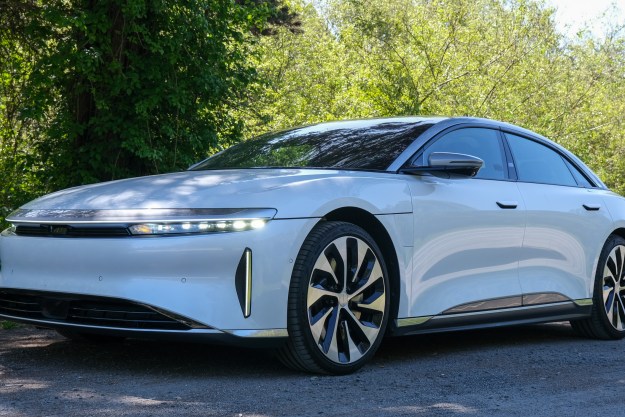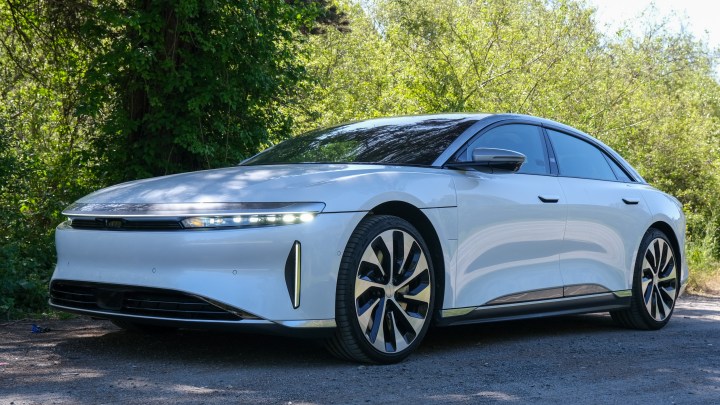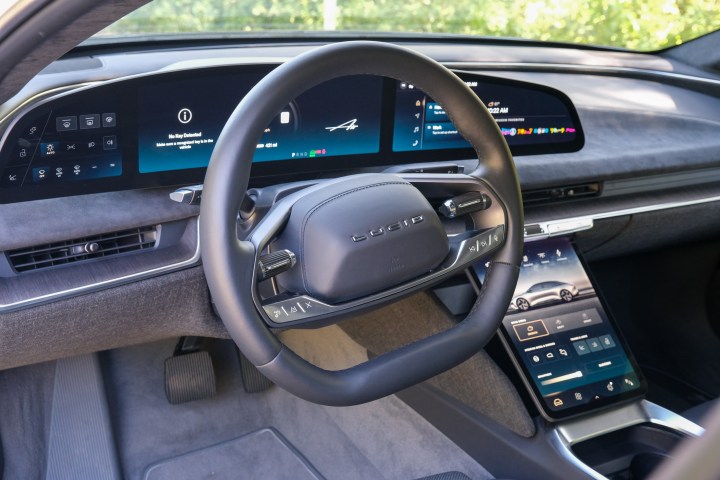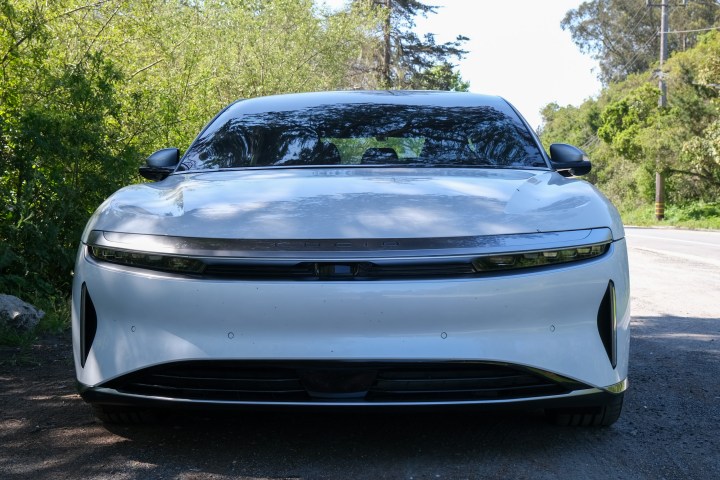
- Unbeatable 512-mile range
- Premium materials inside and out
- Fast and manueverable
- Smart blend of analog and digital controls
- Expensive
- Polarizing style
Electric cars are still in their infancy. The fact is that they’re still working up to a range, charging speed, and charging locations, that can eliminate the worries associated with range anxiety. Even the best EVs have 300 miles or so — and when you consider the fact that the average gas-powered car has a range of over 400 miles, EVs clearly still have a way to go. But there’s one EV that feels a little more mature than the rest. And that’s despite the fact that the car is the first car of a completely new car company.
The Lucid Air is a perfect example of what an electric car in 2023 should be. It has a 500-mile-plus range, offers a thoughtful balance of digital-versus-physical controls, and looks relatively futuristic and premium. And all that for only … $80,000 for the base model.
Sarcasm aside, the Lucid Air definitely feels like the first step towards longer-range, higher-quality electric cars. It isn’t perfect, but it’s getting close. I spent a week driving the car. Here are my thoughts.
A sleek exterior and comfortable interior
The overall design of the Lucid Air is something that had to grow on me. After seeing pictures, and a few on the streets of the San Francisco Bay Area, I admittedly wasn’t convinced that I loved the exterior of the car. Frankly, I still don’t love it. But I don’t dislike it either, and it’s hard to deny the smooth lines and low-to-the-ground look. And, the company has managed to build a nose that doesn’t look completely out of place, like the EQS. The rear of the car looks pretty good too, with a light bar that runs along the entire back.

Maybe my favorite part of the car’s design is the huge, expansive glass roof that stretches along the length of the car. On the inside, that means you have sunshades that are mounted directly to the glass but still look quite nice. The glass is interrupted in a few different areas, like along the center, but it still truly looks great both inside and out. Of course, this is not unique to the Lucid Air, but it’s still a trend that I hope to see catch on more.
The interior of the car is something that I immediately liked. The Air is spacious and comfortable, with premium materials and high-end features. Those include the likes of massagers, seat heating and cooling, and more. Really everything felt very nice, which was surprising for the first car from a new car company.

Perhaps the main event for the interior of the car, however, is the tech.
Screens everywhere
Stretched along the front of the car is a series of screens that you’ll interact with to control different aspects of the car. This, of course, isn’t uncommon — but Lucid definitely seems to have paid attention to ensuring that the displays are useful and easy to navigate.
Let’s go from left to right. All the way at the left is a small display that controls things like headlights and windshield wipers, along with the door for the charging port. The buttons are large enough to tap with a glance, and the headlights, for example, can be automatic — so you may not need to use these controls much anyway.

To the right of that screen is the digital instrument display, which again, is stylish and well-designed. By default, it’s relatively stripped-back and basic, which I see as a good thing. It’ll show information like your speed and how much power you’re using or gaining, without cluttering the interface with unneeded information.
Next up is the infotainment screen, which is where you’ll control audio playback and mapping. Lucid’s interface here is fine, but I didn’t like it quite as much as the other interfaces in the car. Thankfully, Lucid finally added CarPlay support to the Air just a few months ago, and while it’s small and doesn’t fit the display super well, I relied on it for mapping and audio in the car.
So far, all of the screens are joined on one big panel along the front of the car, but the final screen is detached and placed where you would commonly find the gear selector. This screen, I actually really liked. From here, you’ll find controls for the driving mode, along with mirrors, seats, and some climate controls. A good indicator of an easy-to-use interface for me is how my wife handles it — and she was whizzing around the seat massager menu in seconds.

Now, I will admit that accessing the climate controls from the screen isn’t as easy as using physical controls — but Lucid has also included physical climate controls, with a fan speed and temperature selector for the driver and passenger. You can get granular settings from the display, but 90% of the time, you won’t need to navigate to that menu — which is really nice.
The longest-range EV
One of the headline-making features of the Lucid Air is its range, and for good reason. Even the base model of the Lucid Air has a range of up to 410 miles, which is more than any other EV on the market. If you’re willing to shell out for higher-end models like our Lucid Air Grand Touring review model, you can get up to 516 miles. No wonder the Air tops our list of electric cars with the longest range.

That essentially eliminated range anxiety for me. Between normal day-to-day driving and a four-hour road trip (two hours each way), I only charged the car once at the end of my week with the car, and it still had almost 100 miles left on it. I didn’t necessarily go easy on the car either — I spent much of the time in Swift mode and pushed the car as often as possible. With the weather warming up, I often had the A/C on, too.
Even when you ultimately do need to charge the car, it charges pretty quickly. The charging station near me tops out at 150kW, but the car can charge at speeds of around 300kW — which should get that huge battery from 10% to 90% in around 45 minutes. That’s pretty stellar for such a large battery. It’s also worth noting that doesn’t mean you have to wait 45 minutes — we’re all used to filling up the gas tank, but you could charge for 20 minutes and still get back to around 50% or so, which would equate to over 200 miles of range.
Driving in style
With a great range, solid interior design, and a good feature set, all that’s really left is driving the car — and driving it is a whole lot of fun. The Lucid Air Grand Touring in particular is very fast, and its steering is responsive enough, handling corners relatively well. Like any electric car, the acceleration is immediate and engaging, and Sprint mode lives up to the name.

The car has some handy driver-assist features too. You’ll get all the usual features, like adaptive cruise control, forward collision warnings, and blind spot cameras that activate when you use a turn signal. It also has an auto park feature that works quite well. It’s a good suite of assistance features, but also about what you would expect from an EV in 2023.
Conclusions
The Lucid Air proves the concept: Electric cars can have a range that matches their gas-powered counterparts, coupled with modern features and a stylish design.
But the fact that the Air has such a long range means that Lucid has a license to charge a little extra. The Air is in the luxury class of EVs, putting it in the same price category as the likes of the EQS and Model S. If you want the ultimate in interior comfort, then the EQS is probably the way to go. But if you’re looking for tech-forward features and a super long range, then the Lucid Air is the way to go.



